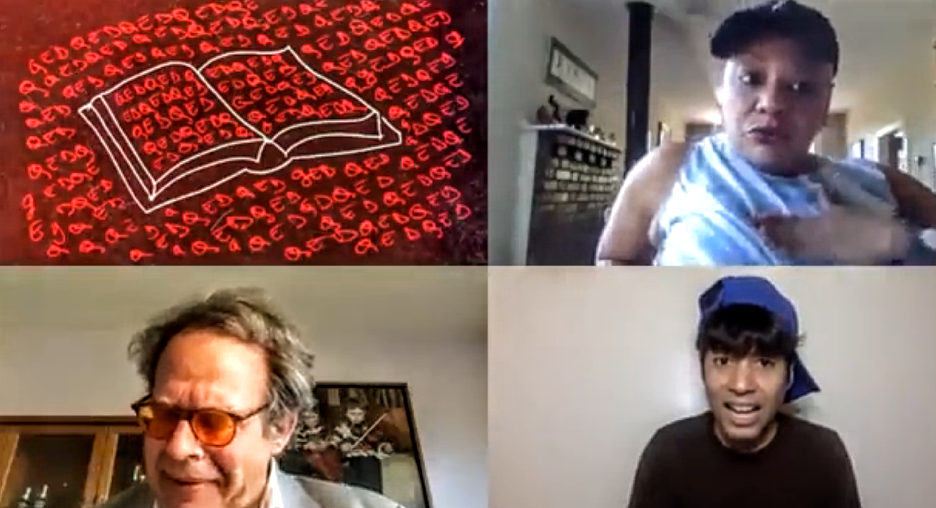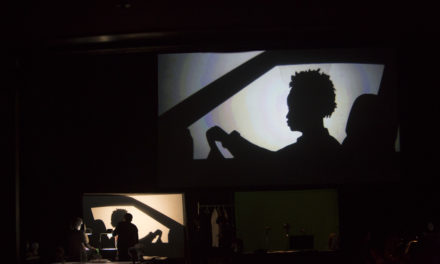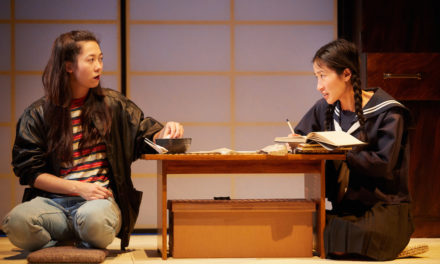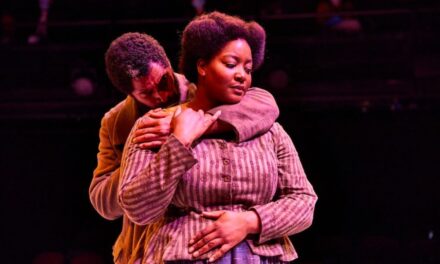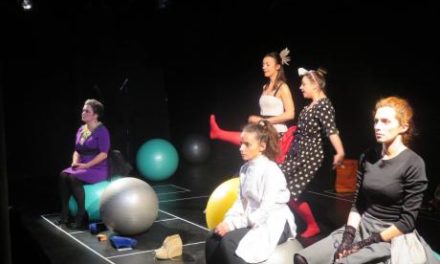The following review is based on the Snowdrops and Chlorine script, which differs slightly from the play’s hybrid recording. To watch the Snowdrops and Chlorine recording, please visit Staging Breast Cancer’s Facebook page.
Catalina Florina Florescu’s Snowdrops and Chlorine, the second installment of her Staging Breast Cancer trilogy, begins with co-protagonist Teddy looking into a mirror and then smashing it into pieces. The mirror is in a hospital where Teddy, a former athlete, has just learned that he has breast cancer. The duality of Teddy’s mirror smashing—acceptance and protest, devastation, and infiniteness—foreshadows the notions of reduction and generation that Florescu dexterously layers into her awareness-raising theatrical production. Outraged by the dearth of cancer education and screening programs in Romania, Florescu, of Romanian descent, crafts Snowdrops and Chlorine as an intervention that stimulates empathy and awareness in audiences. Florescu shapes this intervention both through the narratives of protagonists Teddy and Gabby—a lawyer and breast cancer previvor who, like Teddy, has also been failed by Romania’s lacking services—and projected cancer statistics, video narratives of breast cancer survivors, post-script survey responses from cancer survivors and an on-stage dialogue with survivors, affected family members, medical personnel, and more.
The ongoing unfoldings of Snowdrops and Chlorine entangle the audience, characters, narratives, and means of production in a networked transmutation of Florescu’s research and artistry. Brilliantly conveyed in a mixed-media, multi-linear production, Florescu weaves education, tenderness, humor, and anguish into a single story. She portrays the complexity of what it means to wield a body that is both one’s own and at the mercy of countless external forces, that is both ravished and sustained by something at once from and beyond oneself. Reduction and generation dance through each other in Snowdrops and Chlorine, intertwined and creeping through Gabby and Teddy’s existences, reflecting and shaping their relationships to their cancer, their bodies, their agency, and each other. In swift, cinematic switchings between a hospital, a school, and memory, Gabby and Teddy grapple with an array of experiences during cancer treatment: neglect, resilience, frustration, despair. Florescu illustrates these experiences with strikingly painful imagery. Three of Snowdrops and Chlorine’s most resonant images—the broken mirror, hungry wolves, and a breast-shaped piñata—marry the play to its mission which stems from Florescu’s social engagement as a multimedia storyteller, educator, and artist.
BROKEN MIRROR
Snowdrops and Chlorine’s aspects of complexity and chaos wisely contrast with Teddy’s struggle to accept the contradictions within his body. While ruminating on cancer as a “war with you and with others,” Teddy comments that “once your body breaks, you see your broken pieces scattered all over the house” (22). In this way, the broken mirror reflects how Teddy conceives himself with cancer. As a man, as a former sprint champion, as someone with no family history of breast cancer, he finds himself fractured and fragmented—unable to make sense of his diagnosis. The mirror Teddy shattered hails from a similarly crumbling hospital; The lights flicker, the infrastructure is unstable from earthquakes, and, like the now-broken mirror, it fails to reflect patients as they need to be seen. Prior to its break, this mirror was presumably large enough for others to see Teddy had they had the opportunity. However, as Florescu demonstrates via Teddy’s unsupportive father, toxic masculinity forecloses the ability for others—especially men—to see Teddy as a breast cancer patient and support him accordingly.
While Teddy smashes this mirror upon receiving his diagnosis, Gabby “looks at herself with pride” (18) in a small mirror she produces from her purse during a scene in which she recounts the preventative double mastectomy she sought upon learning of her unfavorable BRCA test results. Gabby’s mirror is small and self-acquired—similar to breast cancer education and services that Florescu describes in Romania. Romania’s lack of preventive procedures requires Gabby to travel to Vienna for her surgery, reflected in the portability of her mirror. The small size, however, offers only enough space for Gabby to see herself. There are no witnesses to her pride, especially since losing her sister and grandmother to cancer. When Gabby returns from Vienna, her colleagues question her sanity for pursuing this procedure.
Despite this isolating position, Gabby creates representation for herself and for others, as both a mammogram advocate and a lawyer fighting medical negligence. Believing “it is not our fault that our bodies break” (25), Gabby turns outward in response to cancer. This reaction is dramatically different than Teddy’s outlook, who turns inward. With a father who repeatedly tells Teddy that he is a “loser” who “contracted a ‘feminine disease’” (17) and a workplace that refuses to increase Teddy’s pay to help him afford treatment (and that eventually fires him), Teddy has internalized the victim-blaming. This inhibits his ability to cope with his cancer and speaks to the ways that gender differences inform his and Gabby’s cancer experiences. While breast cancer is likely Teddy’s first experience as a gender minority, Gabby’s socialization as a woman has prepared her for ridicule, shame, and mistreatment. Snowdrops and Chlorine’s alternation between Gabby and Teddy as adults navigating medical incompetence and Gabby and Teddy as teenagers navigating educational incompetence elucidates the barriers to resilience that privilege bestows; the sexism teenage Gabby faces in these flashbacks demonstrates her practice navigating marginalization unlike Teddy, who—while supporting Gabby’s resistance—has not experienced gender-based inequity. Florescu communicates this difference with care, never dismissing Teddy’s inexperience and intentionally creating Snowdrops and Chlorine for the purpose of educating audiences about the unique challenges that men with breast cancer face. Teddy’s mirror smashing, breaking representation, parallels male breast cancer’s disruption of hegemony. Florescu’s creation breaks and builds representation patterns.
HUNGRY WOLVES
Witness to her late sister’s final moments with cancer, Gabby traverses her sister’s painful journey through cancer’s abyss in Snowdrops and Chlorine’s emotional climax, “These Wolves That My Skin Perspires.” This penultimate scene is inspired by Florescu’s observations of her own late mother, who succumbed to breast cancer and to whom Florescu dedicates the trilogy. In the scene, Gabby recalls her sister, “to die where she spent most of her life” (25)—in her own home, speaking of some hungry wolves who are chasing her. Gabby responds to her sister with tender caretaking though does not understand her wolf descriptions. Gabby presumably attributes this wolf talk to her sister’s metastatic and delirious state, likely born from her overextended capacity rather than dismissive intent. A few months after her sister’s death, however, Gabby, while watching a show about wolves on the Discovery channel, begins to understand what her sister meant: the cancer was “so advanced that the wolves were actually trying to eat what was left out of her” (25).
Earlier in the play, Gabby asks why we “learn about pain only when the needle is inside our veins and the bandage is full with blood” (12). Florescu resists such narrow and reactive understanding of pain through amplifying stories of cancer survivors, engaging explorations of pain through many modalities, and constructing visceral imagery that compels audiences to imagine how much pain a body must endure to conjure wolves. Yet it is Gabby’s chance encounter with a stranger that delivers Snowdrops and Chlorine’s most prescient lesson regarding our ability—or rather inability—to prepare to know pain. As Gabby finds solace in a concerned neighbor following her Discovery channel viewing, the two go out for a drink. Here, Gabby meets an exchange student whose unfamiliar accent helps Gabby hear cancer in a new way. This interaction cues Gabby to understand how “this illness is always new … and we dive into the unknown every freaking single time” (25).
In Gabby’s realization, the play proposes that the most honest way to prepare for pain is to accept our inability to ever fully expect how it will unfold, mutate, and develop. Cancer is random (17). It is unpredictable, infinite in its presentations. Despite human attempts to dominate and control life, cancer defies us. When Gabby names cancer as not completely knowable, the episode’s culmination of pain becomes a release of tension. We of course must learn about pain beyond the moment of the needle in our vein and the bandage being full with blood; We also must understand our inability to preconceive pain’s complexity.
BREAST-SHAPED PIÑATA
In an appendix to the Snowdrops and Chlorine script, Florescu presents the experiences of three breast cancer survivors via their responses to a series of questions. One of the survivors, Rebecca, explains how “there are two common responses to fear of cancer risk: ignore it or become proactive” (29). The interactive ending of Snowdrops and Chlorine drops audiences into a similar moment of reckoning. Following a devastating final scene for Teddy, Gabby begins to hit a breast-shaped piñata that appears on stage at the end of “These Wolves That My Skin Perspires.” As Gabby hits the piñata, “the play ends with the public being invited to participate” (27). Faced with the piñata before them, audiences now literally cannot leave the production without choosing to ignore this breast or to confront it. Through the piñata (inspired by Thedra Cullar-Ledford’s “Lady Part Follies”), Florescu makes visible decisions breast cancer-affected individuals face that are imperceptible to those not affected. This staging moves audiences from witnessing characters’ accounts of such choices to now experiencing a moment of decision making: ignore or confront the breast.
Participatory engagement with the breast piñata cues reflection on the ways that we position the breast as fecund, as we create, yet also exploit it. This theme—the paradox between the breast as a generative life force and something reduced to a sexualized object—appears in other moments as well. To challenge their high school biology teacher’s gender bias in a flashback sequence, Gabby and Teddy bring a Playboy magazine to class claiming it came with the science magazine he recommended they buy. While describing her trip to Vienna for her preventative double mastectomy surgery, Gabby states: “I was not going to birth something, but to get rid of…a piece of meat” (18). Like the magazine and the meat analogy, the collective invitation to strike the breast piñata amplifies the many cultural assumptions and mistreatments that have been imprinted on the breast—capitalistic exploitation, its Playboy-like sexualization, and aestheticization through plastic surgery and prosthetics, existing to be consumed by others. Yet this rupture that scars the breast, as piñata, liberates it. The manifestations of how the play might mutate due to the unpredictability of audience participation reject the singularity of diagnosis, pain, healing, and identity. With audiences both consuming and generating the production—form mirroring content—Snowdrops and Chlorine honors the multitudes of the breast, of cancer, of theater.
Snowdrops and Chlorine’s ending invites the audience to disrupt the societal taboos the piñata-breast symbolizes through the audience’s forceful hitting of the piñata until it breaks, its pieces scattered all over the stage reflecting the shattered pieces of Teddy’s broken mirror. The piñata’s new iteration of pain that portrays how “once your body breaks you see your broken pieces scattered all over the house” (22) illuminates how the mirror smashing may take form when enacted in community and afforded a comprehensive range of representation, emotionality, and care. Unlike Teddy’s mirror smashing, the eruption of the piñata is offered by invitation, which extends permission to respond to cancer, permission to express rage, permission to see the potentiality of broken pieces that is absent to Teddy. This permission to see possibilities from shards cues contemplation on the many dimensions of who and what lead fragmented reflections to so often induce fractured identity. When Teddy shattered the mirror in the opening narration, the hospital staff discarded its shards before Teddy had the opportunity to imagine ways that the mirror’s disconnected pieces might still offer him a unified reflection. Had the hospital staff not immediately discarded Teddy’s mirror shards, perhaps Teddy could have perceived them akin to a mosaic, negative space facilitating rather than obstructing unity.
The swirling piñata shards that rain down remain as a witness to infinite possibilities of what can happen when the body—of a mirror, a piñata, a person—opens and creates space to imagine alternative configurations. Rebecca and Catherine, another survivor in Florescu’s appendix, both chose to not surgically reconstruct their breasts post-mastectomy and instead opted to ‘go flat.’ While going flat was the option that Rebecca and Catherine each felt was best for them, the two described the lack of representation they encountered in going flat—both in near-nonexistent images of femme previvors/survivors who have gone flat and in underwhelming enthusiasm from surgeons regarding this choice (a male breast cancer survivor interviewed in the appendix, meanwhile, did not speak to any lack of enthusiasm from surgeons regarding his going flat). Through having the option to go flat and subsequently becoming an advocate for education about this option, Rebecca (who now facilitates healing workshops for breast cancer patients, survivors, and previvors) found a sense of wholeness. Responding to Florescu’s request to finish the prompt, “Dear breast cancer, ….,” Rebecca explains her surprise in realizing “without my experience of breast cancer, I wonder if I would have become as comfortable with myself, my body, and my feelings. Although I have lost my breasts, I feel more whole than I have felt at any other time in my life before” (29). And yet Catherine’s response (“Dear Breast Cancer…you don’t define me”) represents the diverse reactions to breast cancer. The infinite possibilities for Snowdrops and Chlorine’s ending appropriately reflect this multiplicity and attest to Florescu’s eloquence in re-presenting lived experiences.
Snowdrops and Chlorine’s ending with the piñata experience offers a preamble to Cancer Choreography, Florescu’s in-progress final installment of her Staging Breast Cancer trilogy. This third act existing “with no spoken words” (2) may hopefully bring a multiplicity to the breast cancer experience that Snowdrops and Chlorine characters felt missing under logos alone. Our excitement for this medium is not to minimize the powerful words of Snowdrops and Chlorine; The multi-media design of this play—incorporation of film, nonverbal physicality that ends several scenes, participatory piñata smashing—remind us that language can retain its beauty and power when paired with other media in harmony. Snowdrops and Chlorine explores affirmation and disavowal of life through the play’s celebration of plural media, forms, education methods, genders, and experiences. Florescu’s standout integration of these areas locates her as exactly the type of artist this world needs.
Hannah Trivilino and Vassiliki Rapti are members of civic art and media collective Citizen TALES Commons. They decided to co-author this review as a praxis of unity, believing that we further connectedness via our joint writing. The collaborative review additionally reflects the ways that Citizen TALES Commons members (among whom include Dr. Florescu) support and empower each other in their scholarly, civic, and artistic endeavors. For more information about Citizen TALES Commons, please visit www.citizentales.squarespace.com.
This post was written by the author in their personal capacity.The opinions expressed in this article are the author’s own and do not reflect the view of The Theatre Times, their staff or collaborators.
This post was written by Hannah Trivilino and Vassiliki Rapti.
The views expressed here belong to the author and do not necessarily reflect our views and opinions.

